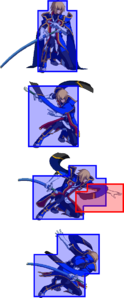Behind the scenes of a fighting game, the properties of attacks and characters are defined by hitboxes. These show where exactly an attack can hit and where a character can be hit.
- What the player sees and what the game engine sees
Definitions
- Hitbox
- Refers to all types of boxes discussed in this section such as attackboxes and hurtboxes
- Attackbox
- Where the attack can hit the opponent. These are typically colored red.
- Hurtbox
- Where the character can be hurt if struck. These are typically colored blue or green.
- Collisionbox
- Where the character currently takes up space. Collisionboxes can not overlap, and will instead push each other from side to side, such as when characters walk into each other. These do not have a color commonly used.
These are just some of the common types of hiboxes. Depending on the game there may be specific boxes for throws, projectiles, assists, etc.
Common Hitbox Trends
Let's look how some common moves behave and see what we can learn.
Extended Hurtboxes
- Most attacks extend the character's hurtboxes
A typical attack extends the character's hurtbox. This means that blindly doing attacks from neutral has some risk as you are briefly making yourself a bigger target. You can be hit out of the startup of your attack or be punished for whiffing. Not all attacks have extended hurboxes during attacks, but it is true more often than not.
Reduced Hurtboxes
Some moves shrink your hurtbox significantly. This is especially prevalent in Guilty Gear's 6P anti air attacks.
Disjointed Hitbox
While most moves have attackboxes and hurtboxes fairly close to each other, some don't; these moves are typically strong for beating out other moves in that direction. For example, Ky's 6P is strong against air attacks since he's not hittable above his knees, and Slayer's 2H can't be hit below his knees, making it useful for beating opponents using low attacks.
Misleading Hitboxes
- Hitboxes don't have to make real-world sense
Hurtboxes can even extend to things that don't normally make sense like weapons, capes, or even the empty space around them. Sometimes attackboxes strike more (or less) area than they visually appear.
Attribute Invincibility
While not directly hitbox related, Attribute Invincibility is worth mentioning here since a lot of ASW games use it. In BlazBlue and Dragon Ball FigherZ each attack is tagged with an attribute, such as Head, Body, Foot, or Projectile. Certain attacks have invincibility to certain attributes for a set amount of time.
A common example of this is 2H attacks in Dragon Ball - they have invincibility to Head attribute attacks and almost all airborne attacks are Head attribute. Thus you could say that you effectively have no hurtbox versus airborne attacks.
Common Situations
Some hitbox interactions are easy to explain, while others are more confusing at first glance. Let's review some to gain a better understanding of them.
Hitting an Opponent
- HitboxHitExtendedHitbox.png
Hitting an extended hurtbox
An attackbox intersects with the opponent's hurtbox. While this sounds easy, certain interractions will appear "strange" without slowing things down or applying the concept of extended/reduced hurtboxes.
In the second example, we see Jin do an attack with an extended hurtbox, and Ragna positioned to hit him. Remember, positioning is important - too close and Jin's sleeves would hit Ragna's head, too far and Ragna'a fist would miss.
This occurs less often but can be very jarring to see, and thus merits further explanation.
Clash
Clashes in most ASW games occur when an attackbox intersects with the opponent's attackbox.
Estimating Hitboxes Without Datamining
Not all games will have hitboxes available - this is especially true with new games on new engines. But that doesn't mean you don't have any hitbox information at all, you can test things yourself and make estimates on the location of hitboxes/hurtboxes.
Observe In-Game
- First assume that the hitboxes are exactly where the animation shows it to attack. And the hurtboxes are located in the same space the character occupies.
- Notice when unexpected hits/misses happen
- Did your move have more/less range than you thought?
- How easy/difficult is it for the opponent to hit you out of a specific move?
- Did you dodge an attack unexpectedly?
- Make a note of it in your mind and experiment in training mode.
Experiment in Training Mode
- In training mode, try to hit the opponent from different angles that you don't usually use to get an idea how big the hitbox/hurtbox for any attack are in a specific direction.
- For example,
Combining with Frame Data
Judging moves based solely on its hitboxes is not enough, speed is an equally important factor, and
















